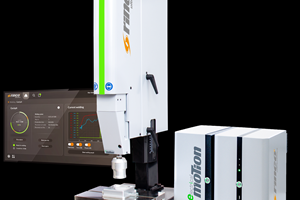Inline Inkjet Printer Keeps Pace With Speedy Wire & Cable Processor
Huber+Suhner is outfitting its six high-speed extrusion lines with new high-speed, continuous inkjet printers.
What appears to be one of the world’s fastest continuous inkjet (CIJ) printers is enabling a wire and cable processor to boost the production and printing quality of its electrical and optical communications products. Switzerland’s Huber+Suhner AG (H+S) has installed a new inline JET Rapid CIJ printer from Germany’s Paul Leibinger GmbH & Co., (U.S. office in East Troy, Wis.) on one of its six high-speed extrusion lines and plans the same for the rest, according to H+S project manager Thomas Haab. The printers reportedly can generate “reliably legible typography” on wire/cable and pipe extrusion lines, where speeds can exceed 3280 ft/min, says Christina Leibinger, the machine builder’s managing director.
The unit was developed by Leibinger to ensure that its printers did not become a bottleneck in high-speed extrusion systems used in wire/cable and pipe manufacturing. Top-range production systems for coating electrical or fiber-optic wires are operating at increasingly higher speeds. According to Leibinger, these speeds threaten to bring traditional printers located downstream to their knees: The manufacturer’s name, logo, batch number and length label become distorted if not altogether illegible. If the printer hits its limit for a mere two minutes, more than 6500 ft of expensive cable gets tossed.
H+S’s low-frequency technology segment currently runs 18 extrusion lines, according to Haab. “Most of our cable jacketing is made of crosslinked PE. All crosslinked compounds are developed and produced by H+S.” The company had previously used gravure wheel printing systems, as other printing units were not fast enough for the speeds desired. Before buying the Leibinger inline CIJ printer, the company evaluated several other systems, including wheel printing and other brands of inkjet printing. “We tested different suppliers’ equipment regarding speed, print quality and process safety,” explains Haab, who adds that these tests showed only the Leibinger unit could achieve the required speeds.
Other key advantages cited by Haab include eliminating the issue of printing-wheel wear; the ability to change printing text in seconds; printing flexibility, including the ability to print order numbers, production date and special customer requests; and a clean working environment. Moreover, the printer’s unique automatic closure system is said to provide exceptional reliability. In this Sealtronic system, the gutter is retracted and the nozzle is closed to create an airtight seal when the printer is not working.
This prevents the ink from drying out and blocking the nozzle—eliminating time-consuming cleaning. Leibinger claims its new CIJ printer can print at a rate “impossible for the human eye to see.” A minute spray nozzle in the cylinder-shaped printhead, mounted above the cable, fires 128,000 electrically charged ink drops towards the gutter every second. A high-voltage field between the gutter ends changes the trajectory of individual ink drops. The drops land on the cable as pixels and are dry in less than a second.
According to Leibinger, information such as the manufacturer’s name, data-matrix code, and graphics appear on the cable as if painted by an invisible hand. And not just in black, yellow and blue; further developments allow the JET Rapid to now print easily readable white text on black cables through use of specially pigmented inks.
Related Content
High-Throughput, Robust Thermoformer
NPE2024: WM Thermoforming’s new generation of FC1000 IM2 offers the highest throughput per square feet.
Read MorePolyfuze Graphics Corp. Partners With RFID Specialists
To help customers navigate the complexities of RFID technology, Polyfuze has partnered with such companies as HID Global.
Read MoreNext-Generation Fully Electric Ultrasonic Welding System
NPE 2024: Rinco new eMotion servo-driven machine is available in 20 kHZ and 35 kHz frequencies.
Read MoreCobot Automates Label Reel Loading for High-Volume PET Beverage Bottles
Sidel’s new CoboREEL system uses a cobot to automate a shift’s worth of label reel loading.
Read MoreRead Next
People 4.0 – How to Get Buy-In from Your Staff for Industry 4.0 Systems
Implementing a production monitoring system as the foundation of a ‘smart factory’ is about integrating people with new technology as much as it is about integrating machines and computers. Here are tips from a company that has gone through the process.
Read MoreLead the Conversation, Change the Conversation
Coverage of single-use plastics can be both misleading and demoralizing. Here are 10 tips for changing the perception of the plastics industry at your company and in your community.
Read More










